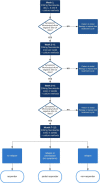Guideline: Vulvovaginal candidosis (AWMF 015/072, level S2k)
- PMID: 33529414
- PMCID: PMC8248160
- DOI: 10.1111/myc.13248
Guideline: Vulvovaginal candidosis (AWMF 015/072, level S2k)
Abstract
Approximately 70-75% of women will have vulvovaginal candidosis (VVC) at least once in their lifetime. In premenopausal, pregnant, asymptomatic and healthy women and women with acute VVC, Candida albicans is the predominant species. The diagnosis of VVC should be based on clinical symptoms and microscopic detection of pseudohyphae. Symptoms alone do not allow reliable differentiation of the causes of vaginitis. In recurrent or complicated cases, diagnostics should involve fungal culture with species identification. Serological determination of antibody titres has no role in VVC. Before the induction of therapy, VVC should always be medically confirmed. Acute VVC can be treated with local imidazoles, polyenes or ciclopirox olamine, using vaginal tablets, ovules or creams. Triazoles can also be prescribed orally, together with antifungal creams, for the treatment of the vulva. Commonly available antimycotics are generally well tolerated, and the different regimens show similarly good results. Antiseptics are potentially effective but act against the physiological vaginal flora. Neither a woman with asymptomatic colonisation nor an asymptomatic sexual partner should be treated. Women with chronic recurrent Candida albicans vulvovaginitis should undergo dose-reducing maintenance therapy with oral triazoles. Unnecessary antimycotic therapies should always be avoided, and non-albicans vaginitis should be treated with alternative antifungal agents. In the last 6 weeks of pregnancy, women should receive antifungal treatment to reduce the risk of vertical transmission, oral thrush and diaper dermatitis of the newborn. Local treatment is preferred during pregnancy.
Keywords: Candida; candidosis; diagnosis; therapy; vulvovaginal candidosis.
© 2021 The Authors.Mycoses published by Wiley-VCH GmbH.
Conflict of interest statement
Conflicts of interest statements of the authors are given in the German full‐text version:
Figures
References
-
- Sobel JD. Vulvovaginal candidosis. Lancet. 2007;369(9577):1961‐1971. - PubMed
-
- Cole AM. Innate host defense of human vaginal and cervical mucosae. Curr Top Microbiol Immunol. 2006;306:199‐230. - PubMed
-
- Denning DW, Kneale M, Sobel JD, Rautemaa‐Richardson R. Global burden of recurrent vulvovaginal candidiasis: a systematic review. Lancet Infect Dis. 2018;18(11):e339‐e347. - PubMed
Publication types
MeSH terms
Substances
Grants and funding
LinkOut - more resources
Full Text Sources
Other Literature Sources


